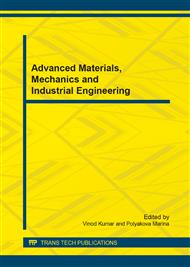[1]
Liberson W, Holmquest H, Scott M. (1961). Functional electrotherapy: Stimulation of the common peroneal nerve synchronised with the swing phase of gait of hemiplegic subjects. Arch Phys Med Rehabil 42. 202-205.
Google Scholar
[2]
Hamzaid N. A., Pithon K. R., Smith R., and Davis G. M. Functional electrical stimulation elliptical stepping versus cycling in spinal cord-injured individuals., Journal of Clinical Biomechanics Vol. 27, pp.731-737, (2012).
DOI: 10.1016/j.clinbiomech.2012.03.005
Google Scholar
[3]
Prosser L.A., Stanley C.J., Norman T.L., Park H.S. and Damiano D. L. Comparison of Elliptical Training, Stationary Cycling, Treadmill Walking and Overground Walking Electromygraphic Patterns., Journal of Gait and Posture, Vol. 33, pp.244-250, (2011).
DOI: 10.1016/j.gaitpost.2010.11.013
Google Scholar
[4]
Porcari J., Foster C. and Schneider P. Exercise Response to Elliptical Trainers., Fitness Management Article, August (2000).
Google Scholar
[5]
Ferrarin M., Palazzo F., Reiner R. and Quintern J. Model Based Control for FES-Induced Single Joint Movements., IEEE Transaction on Neural Systems and Rehabilitation Engineering, Vol. 9 No. 3, pp.245-257, Sept (2001).
DOI: 10.1109/7333.948452
Google Scholar
[6]
Zhang Q., Hayashibe M., Fraisse P. and Guiraud D. FES-Induced Torque Prediction with Evoked EMG Sensing for Musce Fatique Tracking., IEEE/ASME Transactions on Mechatronics, Vol. 16 No. 5, pp.816-826, Oct (2011).
DOI: 10.1109/tmech.2011.2160809
Google Scholar
[7]
Ajoudani A. and Erfanian A. A Neuro-Sliding-Mode Control With Adaptive Modeling of Uncertainty for Control of Movement in Paralyzed Limbs Using Functional Electrical Stimulation., IEEE Transactions on Biomedical Engineering, Vol. 56 No. 7, pp.1771-1780, July (2009).
DOI: 10.1109/tbme.2009.2017030
Google Scholar
[8]
Kobravi H. R. and Erfanian A. Decentralized Adaptive Robust Control Based on Sliding Mode and Nonlinear Compensator for the Control of Ankle Movement using Functional Electrical Stimulation of Agonist-Antagonist Muscles,. Journal of Neural Engineering, Vol 6, pp.1-10. (2009).
DOI: 10.1088/1741-2560/6/4/046007
Google Scholar
[9]
S.Z. Yahaya, Z. Hussain, R. Boudville and M. N Taib. Dynamic Modeling and Control of Wheel-chaired Elliptical Stepping Exercise., Proceeding of the IEEE International Conference on Control System, Computing and Engineering, pp.204-209 Penang, Malaysia, (2012).
DOI: 10.1109/iccsce.2012.6487142
Google Scholar
[10]
S.Z. Yahaya, Z. Hussain and R. Boudville. Electrically Stimulated Quadriceps Muscle Model for Wheel-chaired Elliptical Stepping Exercise., Fifth International Conference on Computational Intelligence, Communication Systems and Networks, Madrid Spain, pp.115-119, 5-7 June (2013).
DOI: 10.1109/cicsyn.2013.70
Google Scholar
[11]
Riener R. and Fuhr T. Patient-Driven Control of FES-Supported Standing Up: A Simulation Study, IEEE Transactions on Rehabilitation Engineering, Vol. 6, No. 2, June (1998).
DOI: 10.1109/86.681177
Google Scholar
[12]
S.Z. Yahaya, Z. Hussain and R. Boudville. Design and Simulation of Wheel-chaired Elliptical Stepping Exercise for Stroke Rehabilitation., 13th IEEE International Conference on Bioinformatics and BioEngineering, Chania, Greece, Nov (2013).
DOI: 10.1109/bibe.2013.6701668
Google Scholar
[13]
Gu Chengwei and Jun Qian, Optimized proportional-integral-derivative control strategies and simulation for Lower Limb Functional Electrical Stimulation., Fourth International Conference on Information and Computing, pp.420-423, (2011).
DOI: 10.1109/icic.2011.91
Google Scholar
[14]
M. Ferrarin, E.E. Pavan, R. Spadone, R. Cardini and C. Frigo, Standing-up Exerciser based on Functional Electrical Stimulation and Body Weight Relief., Medical & Biological Engineering and Computing, Vol. 40, pp.282-289, (2002).
DOI: 10.1007/bf02344209
Google Scholar
[15]
J. Kennedy and R. Eberhart, Particle swarm optimization, in Proc. IEEE Int. Conf. Neural Networks, p.1942–1948, (1995).
Google Scholar


